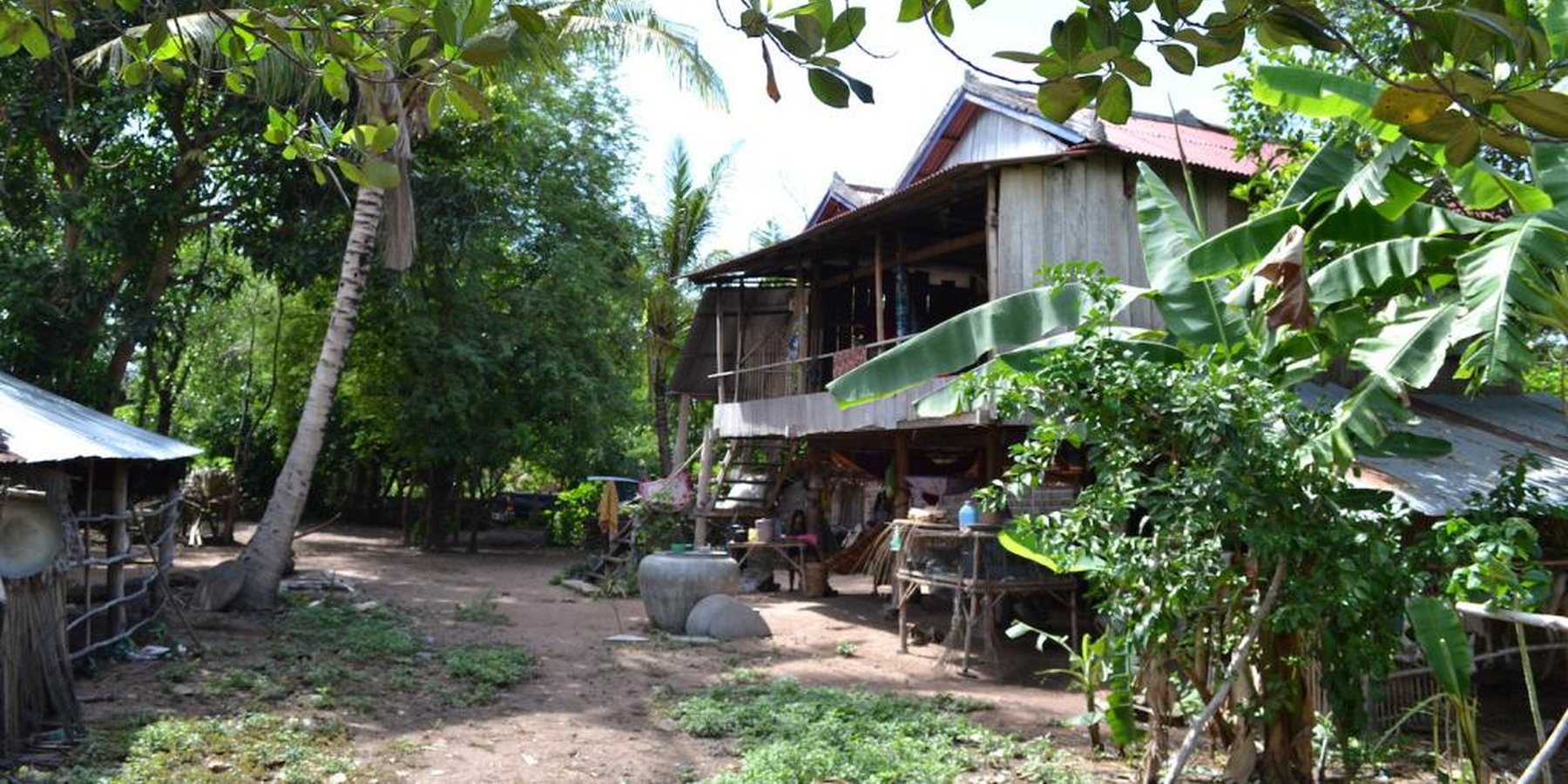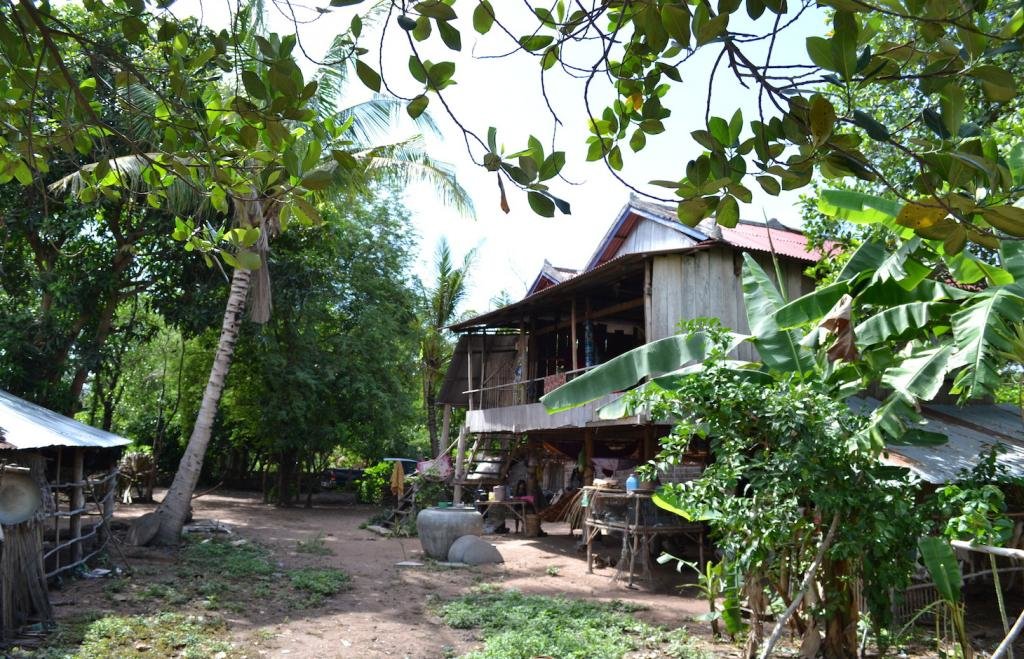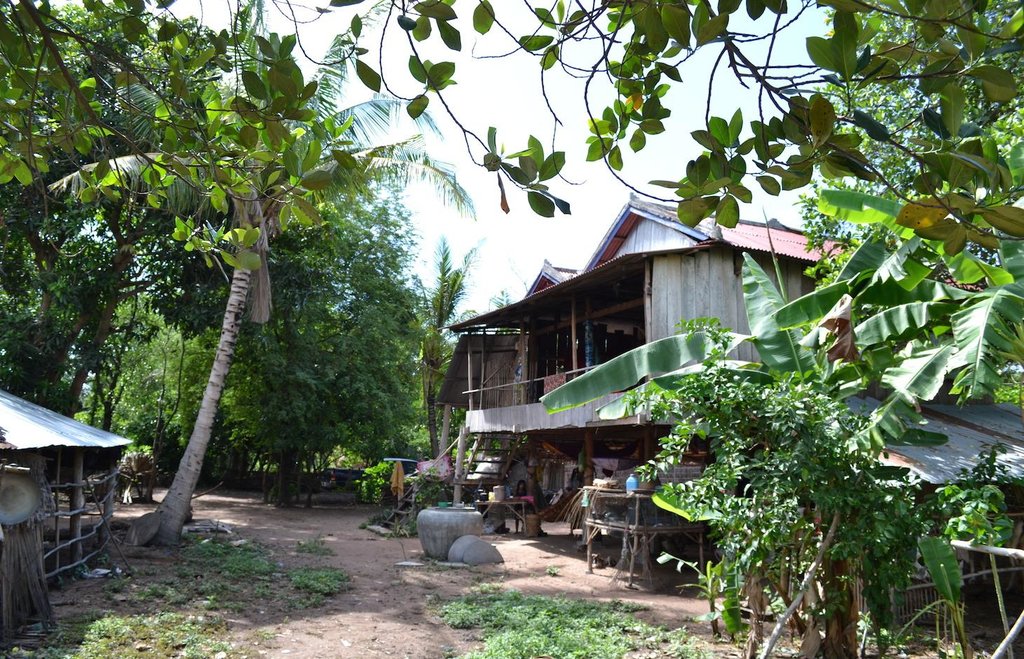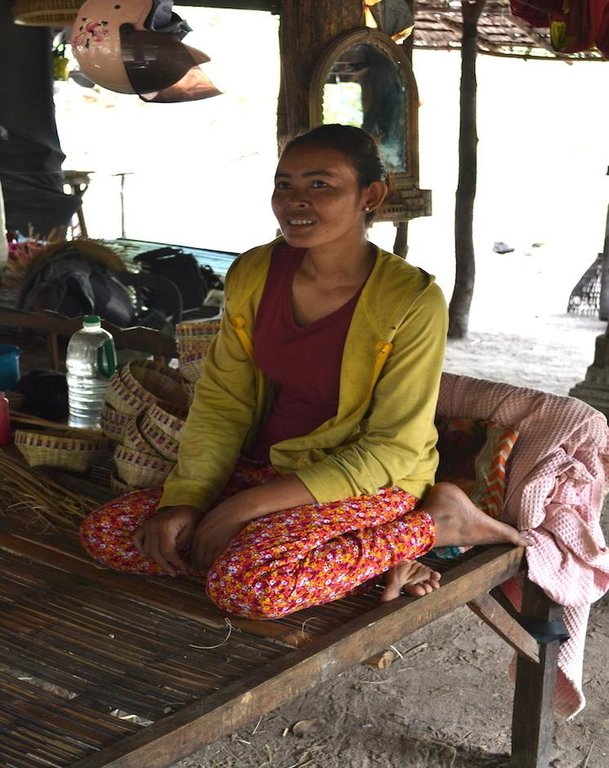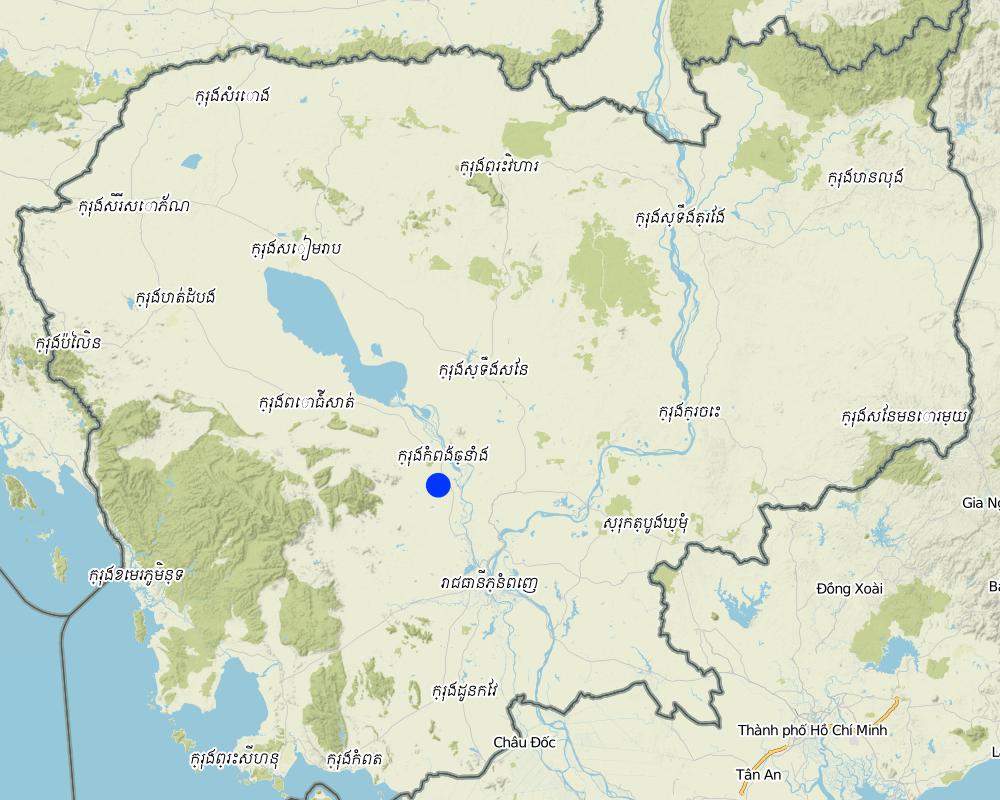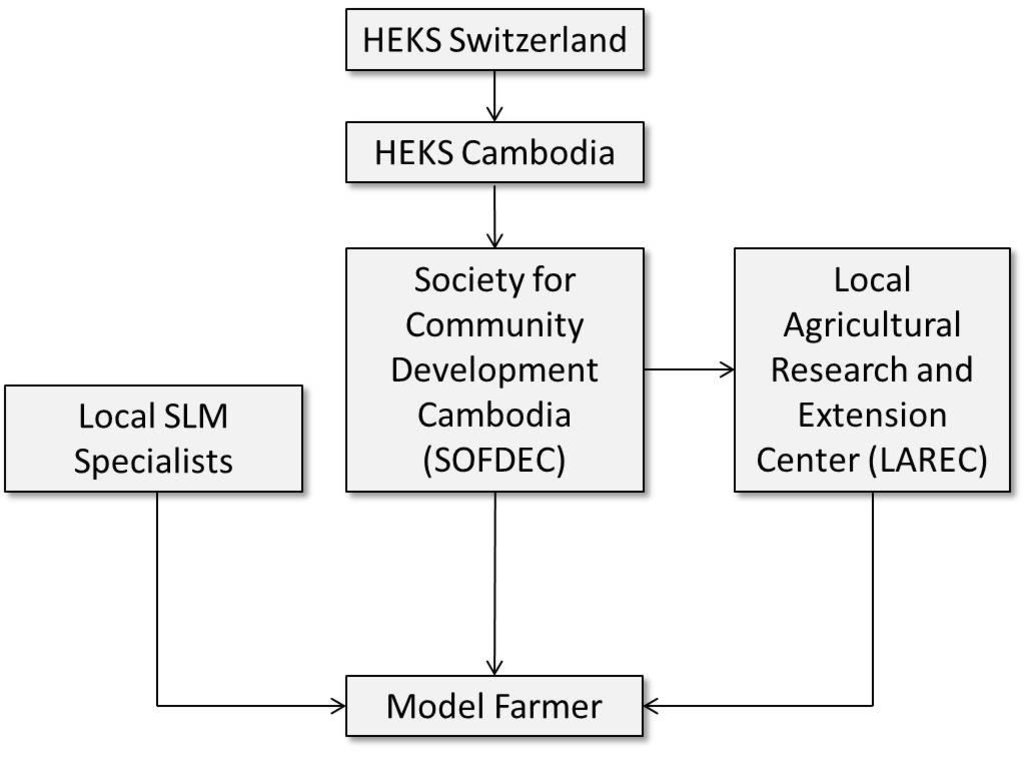Model farmer [กัมพูชา]
- ผู้สร้างสรรค์:
- การอัพเดท:
- ผู้รวบรวม: Christoph Kaufmann
- ผู้เรียบเรียง: –
- ผู้ตรวจสอบ: David Streiff
approaches_2498 - กัมพูชา
ดูส่วนย่อย
ขยายทั้งหมด ย่อทั้งหมด1. ข้อมูลทั่วไป
1.2 รายละเอียดที่ติดต่อได้ของผู้รวบรวมและองค์กรที่เกี่ยวข้องในการประเมินและการจัดเตรียมทำเอกสารของแนวทาง
ผู้เชี่ยวชาญ SLM:
ผู้เชี่ยวชาญ SLM:
Say Mesa
Society for Community Development in Cambodia
กัมพูชา
ผู้เชี่ยวชาญ SLM:
Bin Sreytouch
Society for Community Development in Cambodia
กัมพูชา
ผู้เชี่ยวชาญ SLM:
Khun Lean Hak
SOFDEC/LAREC
ชื่อของโครงการซึ่งอำนวยความสะดวกในการทำเอกสารหรือการประเมินแนวทาง (ถ้าเกี่ยวข้อง)
Local Agricultural Research and Extension Centre (LAREC) - กัมพูชาชื่อของโครงการซึ่งอำนวยความสะดวกในการทำเอกสารหรือการประเมินแนวทาง (ถ้าเกี่ยวข้อง)
Society for Community Development in Cambodia (SOFDEC) - กัมพูชาชื่อของโครงการซึ่งอำนวยความสะดวกในการทำเอกสารหรือการประเมินแนวทาง (ถ้าเกี่ยวข้อง)
CDE Centre for Development and Environment (CDE Centre for Development and Environment) - สวิตเซอร์แลนด์1.3 เงื่อนไขที่เกี่ยวข้องกับการใช้ข้อมูลที่ได้บันทึกไว้ผ่านทาง WOCAT
วันที่เก็บรวบรวมข้อมูล (ภาคสนาม):
25/06/2014
ผู้รวบรวมและวิทยากรหลักยอมรับเงื่อนไขเกี่ยวกับการใช้ข้อมูลที่ถูกบันทึกผ่านทาง WOCAT:
ใช่
1.4 การอ้างอิงถึงแบบสอบถามเรื่องเทคโนโลยี SLM
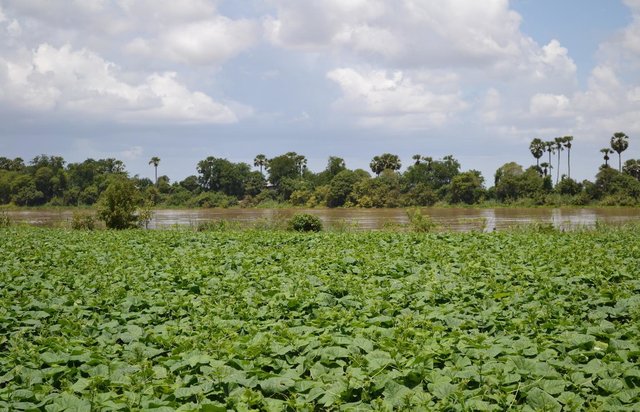
Mulching with water hyacinth (Eichhornia crassipes) after the … [กัมพูชา]
Water hyacinth (Eichhornia crassipes) is collected during the monsoon floods, attached to poles on the flooded fields, chopped when the water recedes and used as mulch to plant different crops.
- ผู้รวบรวม: Christoph Kaufmann
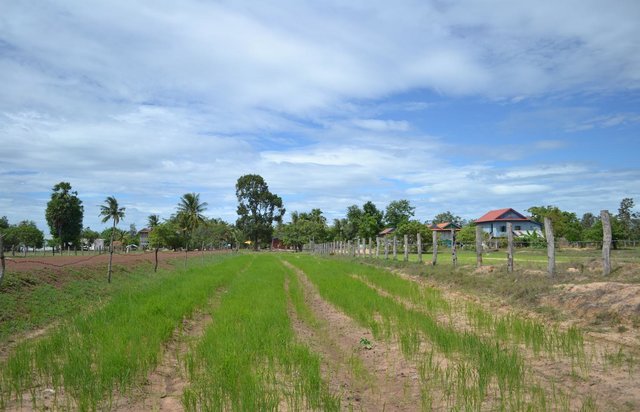
Adapted System of Rice Intensification (SRI) principles in … [กัมพูชา]
Some points of the System of Rice Intensification (SRI) technology, like the row transplanting of young seedlings and the use of compost are adapted and applied in Kampong Chhnang.
- ผู้รวบรวม: Christoph Kaufmann
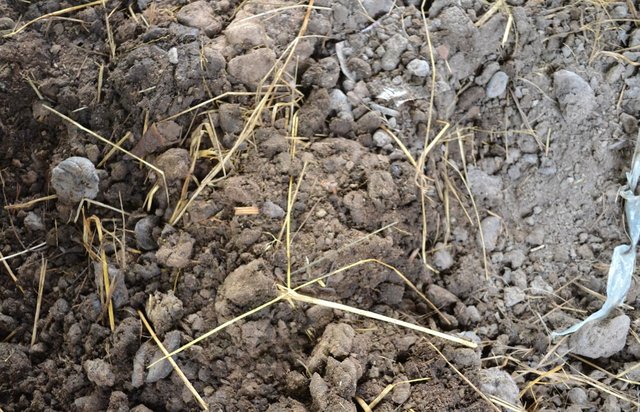
Compost application on rice fields [กัมพูชา]
Manure, leaves and rice straw are gathered in a compost house and the produced compost is applied twice a year to the rice field.
- ผู้รวบรวม: Christoph Kaufmann
2. คำอธิบายของแนวทาง SLM
2.1 การอธิบายแบบสั้น ๆ ของแนวทาง
Model farms were introduced by a NGO in order to spread knowledge about SLM (compost, System of Rice Intensification SRI, and other technologies) in the project area.
2.2 การอธิบายอย่างละเอียดของแนวทาง
การอธิบายอย่างละเอียดของแนวทาง:
Aims / objectives: Model farms were introduced to Kampong Chhnang Province in order to spread knowledge about SLM Technologies.
Methods: The Approach focuses on various areas of farming, and the model farms are clustered into 4 groups:
1. Compost and System of Rice Intensification focus on rice productivity and soil improvement.
2. SLT (Seasonal Long Training) – growing techniques for different crops, seedling germination, care taking, harvesting, etc.
3. INTEREST – focus on different crops which are mixed, crop rotation (rice-watermelon-corn, e.g.), mulching, cover cropping.
4. Cow raising model farmers – focus on fodder production, vaccination, supplementary feed for the cows, stable construction.
In this case study, the model farmer applies the System of Rice Intensification (SRI) and compost (cluster 1).
Stages of implementation: Becoming a model farmer consists of different steps. First, different land users who dispose of the required inputs (certain amount of land, labour availability, motivation for innovation) are invited to a training organized by a local NGO. After the training, the model farmers are chosen amongst the participating land users. These newly elected model farmers get further training from the NGO. While implementing the selected Technologies (in this case SRI and compost), the model farmers are subsidized and monitored by the NGO.
Role of stakeholders: The role of the stakeholders is both active and passive. While they are invited to the initial training provided by the local NGO (passive), the land users decide - once they're selected as model farmers - by themselves which Technologies they want to apply on their fields (active).
Other important information: The benefits of this Approach are manifold. Firstly, it helps spreading knowledge about sustainable land management in the project area. In the case of Cambodia this is especially important since much of the agricultural knowledge was lost during the Khmer Rouge regime (1975-1979). Furthermore, the soils in the project area are sandy and show a low fertility. Therefore for example compost making can have a positive long term impact on both the natural and the human wellbeing. Secondly, model farmers can have a positive impact on local institutions. It is for example possible for the farmers to give a report to local authorities where they state what the villagers need most. Furthermore, model farmers can become members of NGOs or local authorities, or monitor other farmers in their activities.
The main disadvantage of the Approach is the problem of sustainability. Model farmers are in close cooperation with the local NGO, and if the NGO stops the coaching, it is not ensured that the implemented Technologies will continue. This is illustrated by many abandoned compost houses in the area. Also, the interviewed model famer expressed that since she became a model farmer, there is more work to do. This can be detrimental in an environment where a high migration rate decreases the available labour force. Last but not least the decision about which Technologies are to be applied on the given model farms are mainly taken by the SLM specialists working for the local NGO. If land users were more involved in the decision-making process, this might have a positive long term impact on the farmers motivation to continue applying the chosen Technologies independently (sustainability).
2.3 รูปภาพของแนวทาง
2.5 ประเทศ ภูมิภาค หรือสถานที่ตั้งที่ได้นำแนวทางไปใช้
ประเทศ:
กัมพูชา
ภูมิภาค/รัฐ/จังหวัด: :
Kampong Chhnang
ข้อมูลเฉพาะเพิ่มเติมของสถานที่ตั้ง:
Rolear Pha-er
ความคิดเห็น:
For one model farmer, there are approximately 5 other farmers who copy the technologies
Map
×2.6 วันที่เริ่มต้นและสิ้นสุดของแนวทาง
ระบุปีที่เริ่ม:
2006
2.7 ประเภทของแนวทาง
- ใช้โครงงานหรือแผนงานเป็นฐาน
2.8 เป้าหมายหรือวัตถุประสงค์หลักของแนวทาง
The Approach focused on SLM only
On one hand, land users learn about new technologies (e.g. compost, SRI) which have a positive impact on the yields, the soil fertility and in consequence on the income. On the other hand, model farmers are enabled to show these technologies to other land users (knowledge sharing) so these technologies can be spread in the area. One way to share the knowledge are farmer field days where other land users visit the model farms.
The SLM Approach addressed the following problems: Lack of technical knowledge, low agricultural production, low soil fertility.
2.9 เงื่อนไขที่เอื้ออำนวยหรือเป็นอุปสรรคต่อการนำเทคโนโลยีภายใต้แนวทางนี้ไปปฏิบัติใช้
กรอบแนวทางในการดำเนินการด้านกฎหมาย (การถือครองที่ดิน สิทธิในการใช้ที่ดินและน้ำ)
- เอื้ออำนวย
The current situation of land use rights and ownership is rather complicated since there are different perceptions coexisting. Therefore, no concluding statement about the influence of this situation on the implementation of model farms can be made.
- เป็นอุปสรรค
The process of formalizing land use rights in Cambodia is slow. No relationship between this Approach and land use rights.
ความรู้เกี่ยวกับ SLM การเข้าถึงการสนับสนุนด้านเทคนิค
- เป็นอุปสรรค
Other farmers did not have technical knowledge about the technologies
Treatment through the SLM Approach: Farmers could learn from the model farmer, monitoring can help to maintain the best practices.
3. การมีส่วนร่วมและบทบาทของผู้มีส่วนได้ส่วนเสียที่เกี่ยวข้อง
3.1 ผู้มีส่วนได้ส่วนเสียที่เกี่ยวข้องในแนวทางนี้และบทบาท
- ผู้ใช้ที่ดินระดับท้องถิ่นหรือชุมชนระดับท้องถิ่น
Model farms were installed on existing farms.
The involvement of socially and economically disadvantaged group is indirect. They are not selected as model farmers since they don’t have the necessary inputs. However they can benefit from farmer field days or from talking to a model farmer in order to learn about the new technologies.
- ผู้เชี่ยวชาญ SLM หรือที่ปรึกษาการเกษตร
- องค์กรพัฒนาเอกชน
Society for Community Development in Cambodia SOFDEC
- รัฐบาลระดับท้องถิ่น
The Provincial Department of Agriculture PDA was informed about the approach by SOFDEC.
- รัฐบาลแห่งชาติ (ผู้วางแผน ผู้ทำการตัดสินใจ)
At local level, passive
3.2 การเกี่ยวข้องของผู้ใช้ที่ดินระดับท้องถิ่นหรือชุมชนระดับท้องถิ่นในช่วงต่างๆของแนวทาง
| ความเกี่ยวข้องของผู้ใช้ที่ดินระดับท้องถิ่นหรือชุมชนระดับท้องถิ่น | ระบุผู้ที่มีส่วนเกี่ยวข้องและอธิบายกิจกรรม | |
|---|---|---|
| การริเริ่มหรือการจูงใจ | ไม่ลงมือ | The land user attended a workshop organized by SOFDEC/LAREC where he was selected as model farmer. This workshop took place more than 10 years ago. |
| การวางแผน | ปฏิสัมพันธ์ | Farmer plans implementation of compost and SRI |
| การดำเนินการ | จ่ายเงินหรือสนับสนุนจากภายนอก | Money from SOFDEC for compost, 15 USD (in-kind contribution by farmer, e.g. labour, some material (wooden pole) and own money to buy cement, iron roof). Training for compost and SRI. SRI field day. |
| การติดตามตรวจสอบหรือการประเมินผล | ไม่ลงมือ | Coaching by SOFDEC |
| Research | ไม่มี | Research is carried out by LAREC and the results, such as new rice varieties, and brought to the model farmer by SOFDEC. |
3.3 แผนผังแสดงขั้นตอนการทำงาน (ถ้ามี)
คำอธิบาย:
HEKS Switzerland funded the Society for Community Development in Cambodia (SOFDEC), and they support this organisation financially. SOFDEC then funded a research centre on sustainable land management and crops (LAREC) which also maintains an extension service. Together with other local SLM specialists, SOFDEC initiated model farms.
ผู้เขียน:
Stefan Graf (Centre for Development and Environment)
3.4 การตัดสินใจเลือกใช้เทคโนโลยี SLM
ระบุผู้ที่ทำการตัดสินใจเลือกเทคโนโลยีมากกว่าหนึ่งวิธีไปปฏิบัติใช้:
- ผู้เชี่ยวชาญ SLM เป็นผู้ตัดสินใจหลัก ที่ติดตามให้คำปรึกษากับผู้ใช้ที่ดิน
การอธิบาย:
Decisions on the method of implementing the SLM Technology were made by mainly by SLM specialists with consultation of land users
4. การสนับสนุนด้านเทคนิค การสร้างขีดความสามารถ และการจัดการด้านความรู้
4.1 การสร้างขีดความสามารถ / การอบรม
ได้มีการจัดอบรมให้แก่ผู้ใช้ที่ดินหรือผู้มีส่วนได้ส่วนเสียคนอื่น ๆ หรือไม่:
ใช่
ให้ระบุว่าใครเป็นผู้ได้รับการอบรม:
- ผู้ใช้ที่ดิน
รูปแบบการอบรม:
- กำลังดำเนินการ
- จัดคอร์ส
หัวข้อที่พูด:
compost making and on the different steps necessary to implement SRI. The training included both theoretical seminars and on-the-job training.
4.2 การบริการให้คำแนะนำ
ผู้ใช้ที่ดินมีการเข้าถึงการรับบริการให้คำปรึกษาหรือไม่:
ใช่
ระบุว่ามีบริการให้คำปรึกษาหรือไม่:
- ไปเยี่ยมชมสถานที่
การอธิบาย/แสดงความคิดเห็น:
Name of method used for advisory service: Advisory service; Key elements: The Provincial Department of Agriculture delivers some trainings to the farmers in collaboration with SOFDEC , SLM specialists from SOFDEC can get data from the Provincial Department of Agriculture
Advisory service is quite adequate to ensure the continuation of land conservation activities; The involvement of the Provincial Department of Agriculture is supplementary to SOFDEC’s work. Therefore, the land conservation activities could also continue without this advisory service.
4.3 การเสริมความแข็งแกร่งให้กับสถาบัน (การพัฒนาองค์กร)
สถาบันได้รับการจัดตั้งขึ้นมาหรือเสริมความแข็งแกร่งโดยแนวทางนี้หรือไม่:
- ใช่ ปานกลาง
ระบุระดับของสถาบันที่ได้รับการเสริมความแข็งแกร่งหรือจัดตั้งขึ้นมา:
- ท้องถิ่น
ระบุประเภทของการให้ความช่วยเหลือสนับสนุน:
- การสร้างขีดความสามารถ / การอบรม
- decision making
ให้รายละเอียดเพิ่มเติม :
It is possible that model farmers are enabled to influence local institutions through different ways. One possibility is that model farmers can give a report to the village chief and he can give the data to the commune chief. This is a way how the model farmer might influence the decision making within the village. Also, a model farmer can prepare a proposal to the commune chief where he states what the land users need the most (e.g. seeds).
The model farmers can also become facilitators for training other land users on new SLM technologies. Furthermore, the model farmers might be approached by other NGOs or projects to deliver trainings for them, or they might become members of local institutions such as the community council, or join a NGO. It is also possible for model farmers to take part in competitions organized either by NGOs (such as the Excellent Farmer Award) or the Provincial Department of Agriculture.
4.4 การติดตามตรวจสอบและประเมินผล
การติดตามตรวจสอบและประเมินผลเป็นส่วนหนึ่งของแนวทางหรือไม่:
ใช่
ความคิดเห็น:
Technical aspects were regular monitored by project staff, land users through observations; indicators: Training about how to do the Technology (for SRI and compost only once). Changes in the Technology, challenges for applying the Technology.
Economic / production aspects were regular monitored by project staff through measurements; indicators: Yields. SRI: Tillers per plant on 1 m2.
Management of Approach aspects were regular monitored by project staff through observations; indicators: SOFDEC trains the farmers how they can monitor other farmers.
There were no changes in the Approach as a result of monitoring and evaluation
There were few changes in the Technology as a result of monitoring and evaluation: Some Technologies, such as SRI, have been changed considerably since they have first been implemented. However, these changes were not done because of the monitoring, but because of other factors (lack of labour availability, feasibility, etc.).
4.5 การวิจัย
การวิจัยเป็นส่วนหนึ่งของแนวทางหรือไม่:
ใช่
ระบุหัวข้อเรื่อง:
- เทคโนโลยี
ให้ข้อมูลเพิ่มเติมและให้ระบุผู้ทำการวิจัย:
Research is carried out by the Local Agriculture Research and Extension Centre LAREC. LAREC focus their research on different rice varieties (drought resistant, short breeding), and other plants which could be grown in the area (e.g. mung bean, pumpkin, water melon, stylo grass, etc.). The research is influenced by the demands of land users in the target area.
Research was carried out on station
5. การสนับสนุนด้านการเงินและวัสดุอุปกรณ์
5.1 ระบุงบประมาณประจำปีสำหรับแนวทาง SLM นี้
ถ้าหากว่างบประมาณประจำปีไม่เป็นที่ทราบแน่นอน ให้ระบุช่วงลงไป:
- 10,000-100,000
แสดงความคิดเห็น (แหล่งของการระดมทุน ผู้บริจาคคนสำคัญ):
Approach costs were met by the following donors: national non-government (SOFDEC, provides money for compost house and training.): 30.0%; local community / land user(s) (In-kind/money contribution by farmer for compost only): 70.0%
Both model farmers and regular farmers are supported within this project, with total costs of around 20,000$. However, not all of the supported farmers are model farmers. In total, there are 64 model farmers within this project, and we calculated expenditures of about 350 US$ per model farmer.
5.2 การสนับสนุนด้านการเงิน / วัสดุอุปกรณ์ให้แก่ผู้ใช้ที่ดิน
ผู้ใช้ที่ดินได้รับการสนับสนุนด้านการเงิน / วัสดุอุปกรณ์ไปปฏิบัติใช้เทคโนโลยีหรือไม่:
ไม่ใช่
5.3 เงินสนับสนุนสำหรับปัจจัยนำเข้า (รวมถึงแรงงาน)
- การเกษตร
| ระบุปัจจัยนำเข้าที่ได้รับการสนับสนุน | เห็นด้วยระดับไหน | ระบุเงินสนับสนุน |
|---|---|---|
| เมล็ด | ได้รับการช่วยเหลือทางการเงินบางส่วน | |
- วัสดุสำหรับการก่อสร้าง
| ระบุปัจจัยนำเข้าที่ได้รับการสนับสนุน | เห็นด้วยระดับไหน | ระบุเงินสนับสนุน |
|---|---|---|
| Brick and cement | ได้รับการช่วยเหลือทางการเงินบางส่วน | |
ถ้าแรงงานโดยผู้ใช้ที่ดินเป็นปัจจัยนำเข้าที่มีอยู่มากมาย ระบุด้วยว่าเนื่องจาก:
- สมัครใจ
ความคิดเห็น:
The land users get also 15 USD for compost making
5.4 เครดิต
มีการจัดหาเครดิตมาให้ภายใต้แนวทาง SLM หรือไม่:
ไม่ใช่
6. การวิเคราะห์ผลกระทบและการสรุป
6.1 ผลกระทบของแนวทาง
ช่วยให้ผู้ใช้ที่ดินนำเอาเทคโนโลยี SLMไปใช้และบำรุงรักษาสภาพไว้ได้หรือไม่:
- ไม่ใช่
- ใช่ เล็กน้อย
- ใช่ ปานกลาง
- ใช่ อย่างมาก
Compost has a positive impact on the soil, which results in increased production. However, due to a lack of organic matter to make compost with, the land users still use chemical fertilizer in order to increase the rice yields. As for SRI, the yields can be increased while less seeds are used. Also, the use of compost improves soil fertility. However, this Technology needs more labour input, which results in an adaptation of the Technology by the farmer (Technology is only partly carried out as intended by the SLM specialists, and each farmer does it a bit differently).
ทำให้กลุ่มด้อยโอกาสมีอำนาจทางสังคมและเศรษฐกิจหรือไม่:
- ไม่ใช่
- ใช่ เล็กน้อย
- ใช่ ปานกลาง
- ใช่ อย่างมาก
In this area, wealth is usually linked to the amount of land a land user can work on. Poorer farmers that live in the neighbourhood of model farmers can copy the newly implemented technologies and benefit from their positive impacts. However, the likelihood that other farmers implement new technologies depends largely on their complexity and the required inputs. Some technologies are therefore easier and more likely to be implemented by socially and economically disadvantaged groups.
ปรับปรุงประเด็นของการถือครองที่ดินหรือสิทธิในการใช้ ซึ่งขัดขวางการนำเทคโนโลยีไปใช้ให้ดีขึ้น:
- ไม่ใช่
- ใช่ เล็กน้อย
- ใช่ ปานกลาง
- ใช่ อย่างมาก
No relationship between this Approach and land use rights. The problem is unlikely to be overcome in the near future. The process of formalizing land use rights in Cambodia is slow.
Did other land users / projects adopt the Approach?
- ไม่ใช่
- ใช่ เล็กน้อย
- ใช่ ปานกลาง
- ใช่ อย่างมาก
Did the Approach lead to improved livelihoods / human well-being?
- ไม่ใช่
- ใช่ เล็กน้อย
- ใช่ ปานกลาง
- ใช่ อย่างมาก
Through the use of compost, costs to buy chemical fertilizer were reduced. Also the combination of compost and chemical fertilizer led to higher rice yields, the surplus can be sold. For SRI, less rice seeds are needed (lower costs).
Did the Approach help to alleviate poverty?
- ไม่ใช่
- ใช่ เล็กน้อย
- ใช่ ปานกลาง
- ใช่ อย่างมาก
The surplus from higher yields can be sold. Also, SRI requires less seeds and if compost can be implemented (depends if the land user owns cattle or not, and some poor land users don’t own any cattle), the expenses for chemical fertilizers can be reduced.
6.2 แรงจูงใจหลักของผู้ใช้ที่ดินเพื่อที่จะนำ SLM ไปปฏิบัติใช้
- การผลิตที่เพิ่มขึ้น
New varieties and new Technologies contribute to higher yields.
- จิตสำนึกด้านสิ่งแวดล้อม
The farmer collects remaining material (manure) in the fields and backyards, so they are 'cleaner'
- well-being and livelihoods improvement
Higher yields.
6.3 ความยั่งยืนของกิจกรรมของแนวทาง
ผู้ใช้ที่ดินสามารถทำให้สิ่งต่างๆ ที่ได้ปฏิบัติใช้โดยแนวทางนี้ยั่งยืนได้หรือไม่ (โดยไม่มีการสนับสนุนจากภายนอก):
- ใช่
ถ้าตอบว่าใช่ ให้อธิบายว่าอย่างไร :
The land user of this case study is not subsidized any more, but she still continues with the technologies. However, the continuation of the activities depends largely on the personal motivation and the available resources (labour force). Some land users do not continue with compost once they are not monitored anymore.
6.4 จุดแข็งและข้อได้เปรียบของแนวทาง
| จุดแข็ง / ข้อได้เปรียบของแนวทางในทัศนคติของผู้ใช้ที่ดิน |
|---|
| It is good that model farmer are selected in the village since other farmers can learn from them. (How to sustain/ enhance this strength: Model farmers have to lobby with village leader, commune authority and with the NGO to link them with other organisations and Governmental Agencies. ) |
| จุดแข็ง / ข้อได้เปรียบของแนวทางในทัศนคติของผู้รวบรวมหรือวิทยากรหลัก |
|---|
| SLM Technology can be tested in-situ. (How to sustain/ enhance this strength: More innovative technologies could be tested in collaboration with farmers. ) |
| Community sense between the farms is strengthened. (How to sustain/ enhance this strength: Community councils could be created. ) |
| Model farmers are like a bridge between the NGO and other farmers. Projects from NGOs can be carried out more effectively. (How to sustain/ enhance this strength: Create a proper mechanism between the model farmers, the village and commune authorities, and the NGO in order to ensure the sustainability of the model farmer approach beyond the NGOs involvement. ) |
| Other farmers can learn SLM technologies without being directly trained by the NGO (How to sustain/ enhance this strength: Continue with the Approach and seek support from village authorities. ) |
6.5 จุดอ่อน / ข้อเสียเปรียบของแนวทางและวิธีในการแก้ไข
| จุดอ่อน / ข้อเสียเปรียบในทัศนคติของผู้ใช้ที่ดิน | สามารถแก้ไขปัญหาได้อย่างไร |
|---|---|
| The NGO and external people/farmers put workload on model farmers. | Provide compensation to model farmer, show him the benefits of these new Technologies, enable him to participate in local decision making processes. |
| จุดอ่อน / ข้อเสียเปรียบในทัศนคติของผู้รวบรวมหรือวิทยากรหลัก | สามารถแก้ไขปัญหาได้อย่างไร |
|---|---|
| Some Technologies are abandoned once there is no more support from the NGO. | Include long-term monitoring. Also, this monitoring can be carried out by the model farmers or other farmers in the village. |
| The suggested Technologies require more work and are sometimes counter-intuitive to the model farmers (e.g. SRI). | Provide compensation to model farmer, show him the benefits of these new Technologies, enable him to participate in local decision-making processes. |
| The approach is not really participatory since the specialist decide which technologies should be implemented. | First consult the farmers about their needs. Also, include the farmers in case they know about innovative Technologies. |
7. การอ้างอิงและการเชื่อมต่อ
7.1 วิธีการหรือแหล่งข้อมูล
- ไปเยี่ยมชมภาคสนาม การสำรวจพื้นที่ภาคสนาม
- การสัมภาษณ์กับผู้ใช้ที่ดิน
7.3 เชื่อมโยงกับข้อมูลที่มีอยู่บนออนไลน์
ชื่อเรื่องหรือคำอธิบาย:
SOFDEC
URL:
www.sofdec.org
ลิงก์และโมดูล
ขยายทั้งหมด ย่อทั้งหมดลิงก์

Mulching with water hyacinth (Eichhornia crassipes) after the … [กัมพูชา]
Water hyacinth (Eichhornia crassipes) is collected during the monsoon floods, attached to poles on the flooded fields, chopped when the water recedes and used as mulch to plant different crops.
- ผู้รวบรวม: Christoph Kaufmann

Adapted System of Rice Intensification (SRI) principles in … [กัมพูชา]
Some points of the System of Rice Intensification (SRI) technology, like the row transplanting of young seedlings and the use of compost are adapted and applied in Kampong Chhnang.
- ผู้รวบรวม: Christoph Kaufmann

Compost application on rice fields [กัมพูชา]
Manure, leaves and rice straw are gathered in a compost house and the produced compost is applied twice a year to the rice field.
- ผู้รวบรวม: Christoph Kaufmann
โมดูล
ไม่มีโมดูล


